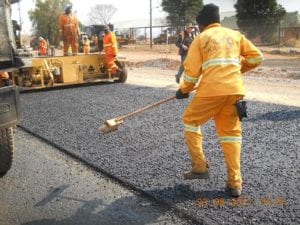Picture: Applying pre-coated chips to the asphalt
After successfully completing the R200-million Phase 1 section of the project in November 2010, which entailed the construction of a dual carriageway between the N14 freeway and Wierda Road, SMEC South Africa was immediately appointed as the project management consultant for Phase 2 of the infrastructure upgrade project undertaken by the Gauteng Provincial Government. This project involved more than R228-million worth of upgrading and rehabilitation work to the 4,2 km section of the R55 carriageway from Sunderland Ridge to Laudium, which is a major arterial road between Johannesburg and Pretoria, which also connects the region to the N14 freeway. SMEC South Africa technical director Tshepo Matshego explains that the company’s scope of work included the upgrade of the road from a single carriageway to a dual carriageway, and the construction of two bridges over the Hennops River. To improve safety and night-time visibility, 10 km of street lighting was installed over the full length of the road, from the N14 interchange into Laudium. “The narrow 6-m-wide single carriageway could not cope with the increased traffic volumes, and SMEC South Africa designed the works such that the appointed contractor constructed the new carriageway, while leaving the existing road open to minimise the impact on traffic,” he explains. “The fully completed carriageway is world class, and is now separated by a wide median and paved shoulder to ensure further motorist safety.”Matshego notes that the erection of the two bridges over the Hennops River proved to be a major challenge, due to the dolomitic nature of the soil, which is prone to sinkholes. “In order to ensure the structural integrity of the bridges, we had to ensure that the bridge piles were securely founded on subsurface rock, which was up to 25 m deep at certain points.”
The piles were successfully sunk using the ODEX piling method, which involves the application of pressurised air during excavation to remove any debris. Matshego adds: “While this method proved to be successful, it did take longer than anticipated to sink the piles, due to the fact that pockets of underground air caused the excavation machinery to jam. Despite this, we managed to reach bedrock with piles varying between 8 m and 25 m in depth.” Matshego highlights the fact that unseasonably high rainfall between December 2010 and March 2011 also proved to be a major challenge. “The heavy rainfall and variability of the ground conditions delayed the piling works for five months, which in turn delayed the progress on the two bridges crossing the Hennops River. Some isolated sinkholes also developed on the road, which required rectification and bridging by utilising geotextiles to strengthen the immediate areas.” In addition to creating a more advanced and efficient road network for motorists, Matshego points out that Phase 2 of the R55 upgrade project also generated skills development within the surrounding community, with more than 150 local jobs being created as a direct result of the project. “All of the locally employed contractors received full training and certificates of qualification in their respective fields, which will go a long way in ensuring that they are better equipped for future employment.”







